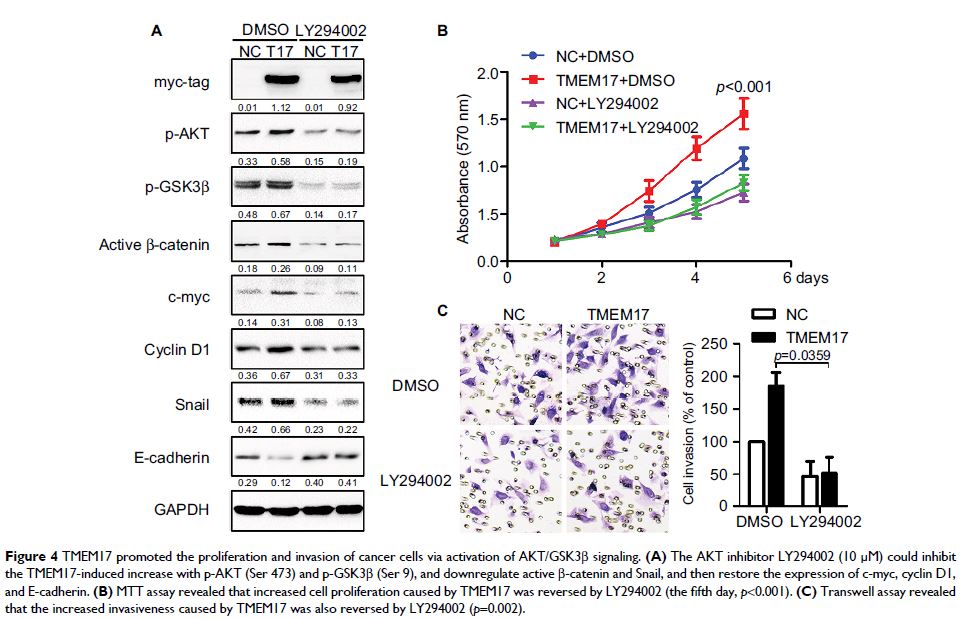108605
论文已发表
注册即可获取德孚的最新动态
IF 收录期刊
- 3.4 Breast Cancer (Dove Med Press)
- 3.2 Clin Epidemiol
- 2.6 Cancer Manag Res
- 2.9 Infect Drug Resist
- 3.7 Clin Interv Aging
- 5.1 Drug Des Dev Ther
- 3.1 Int J Chronic Obstr
- 6.6 Int J Nanomed
- 2.6 Int J Women's Health
- 2.9 Neuropsych Dis Treat
- 2.8 OncoTargets Ther
- 2.0 Patient Prefer Adher
- 2.2 Ther Clin Risk Manag
- 2.5 J Pain Res
- 3.0 Diabet Metab Synd Ob
- 3.2 Psychol Res Behav Ma
- 3.4 Nat Sci Sleep
- 1.8 Pharmgenomics Pers Med
- 2.0 Risk Manag Healthc Policy
- 4.1 J Inflamm Res
- 2.0 Int J Gen Med
- 3.4 J Hepatocell Carcinoma
- 3.0 J Asthma Allergy
- 2.2 Clin Cosmet Investig Dermatol
- 2.4 J Multidiscip Healthc

TMEM17 通过 AKT/GSK3β 信号传导促进乳腺癌的恶性进展
Authors Zhao Y, Song K, Zhang Y, Xu H, Zhang X, Wang L, Fan C, Jiang G, Wang E
Received 20 March 2018
Accepted for publication 14 May 2018
Published 2 August 2018 Volume 2018:10 Pages 2419—2428
DOI https://doi.org/10.2147/CMAR.S168723
Checked for plagiarism Yes
Review by Single-blind
Peer reviewers approved by Dr Colin Mak
Peer reviewer comments 2
Editor who approved publication: Professor Nakshatri
Purpose: Current knowledge of TMEM17, a recently identified protein of the
transmembrane (TMEM) family, is limited, especially with respect to its
expression and biological functions in malignant tumors. This study analyzed
TMEM17 expression in invasive breast cancer tissue and breast cell lines and
its relevance to clinicopathological factors, and investigated the mechanisms
underlying the biological effects of TMEM17 on breast cancer cells.
Patients and
methods: TMEM17 protein expression was
determined in 20 freshly harvested specimens (tumor and paired normal tissues)
by Western blotting. Immunohistochemical analysis was performed to determine
the expression and subcellular localization of TMEM17 in samples from 167
patients (mean age, 49 years) diagnosed with invasive ductal carcinoma (38 with
triple-negative breast cancer; 129 with non-triple-negative breast cancer) who
underwent complete resection in the First Affiliated Hospital of China Medical
University between 2011 and 2013. Furthermore, TMEM17 was knocked down by small
interfering RNAs in breast cancer cell lines.
Results: TMEM17 was found to be significantly upregulated in breast cancer
tissues compared to the corresponding normal breast tissues by Western blotting
(p =0.015). Immunohistochemical
analysis revealed that TMEM was significantly upregulated in invasive breast
cancer cells compared to adjacent normal breast duct glandular epithelial cells
(10.78% vs 76.05%, p <0.001), and
its expression was closely related to the patient’s T-stage (p =0.022), advanced TNM stages (p =0.007), and lymph node
metastasis (p =0.012). After TMEM17 knockdown
or overexpression in breast cancer cell lines, TMEM17 upregulated p-AKT,
p-GSK3β, active β-catenin, and Snail, and downstream target proteins c-myc and
cyclin D1, and downregulated E-cadherin, resulting in increased cancer cell
proliferation, invasion, and migration. These effects were reversed by the AKT
inhibitor LY294002.
Conclusion: Our results indicate that TMEM17 is upregulated in breast cancer
tissues and can promote malignant progression of breast cancer cells by
activating the AKT/GSK3β signaling pathway.
Keywords: proliferation, invasion, migration, β-catenin, Snail
